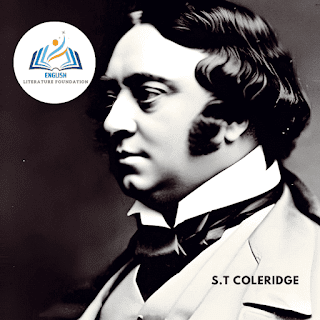"Biographia Literaria" by Coleridge: A Detailed Summary
Biographia Literaria, a seminal work by Samuel Taylor Coleridge, offers a captivating exploration of literature, poetry, and philosophy. In this article, we delve into the depths of Coleridge's magnum opus, uncovering its structure, themes, and enduring significance. From his literary criticism to his philosophy of mind, and even his personal experiences, Biographia Literaria serves as a captivating journey into the mind of a profound thinker.
Introduction
"Biographia Literaria" stands as one of
Coleridge's most renowned works, blending elements of autobiography, literary
criticism, and philosophical musings. It was first published in 1817 and aimed
to provide a comprehensive account of Coleridge's intellectual and poetic
development. Through this work, Coleridge sought to explore the nature of
creativity, imagination, and the role of literature in society.
Background of "Biographia Literaria"
In order to understand the significance of "Biographia
Literaria," it is essential to consider the context in which it was
written. Coleridge intended the work to address misconceptions about his
earlier literary criticism and to clarify his own philosophical and aesthetic
views. Influenced by German idealism and the Romantic movement, Coleridge's
work was deeply rooted in the intellectual climate of his time.
Structure of "Biographia Literaria"
"Biographia Literaria" is divided into two parts,
with numerous chapters that delve into different aspects of Coleridge's
thought. Part I focuses on the theory of poetry and the importance of the
imagination, while Part II delves into more personal reflections, anecdotes,
and metaphysical considerations. The work features a unique blend of prose and
poetry, allowing Coleridge to express his ideas in diverse ways.
Part I: Theory of Poetry and Imagination
This part of "Biographia Literaria" focuses on
Coleridge's theory of poetry and the significance of imagination. In these
chapters, he delves into the nature of poetry, exploring its power to evoke
emotions, create vivid imagery, and transport readers to new realms. Coleridge
emphasizes the importance of the imagination as the driving force behind poetic
creation, distinguishing it from mere fancy.
Part II: Personal Reflections and Metaphysical Considerations
The second part of "Biographia Literaria" takes a
more personal turn, as Coleridge reflects on his own experiences and explores
metaphysical concepts. He shares anecdotes from his life, discussing his
struggles, influences, and encounters with other literary figures of his time.
These personal narratives add depth and context to his philosophical and
literary musings.
Chapters on Literary Criticism
Throughout "Biographia Literaria," Coleridge
devotes several chapters to literary criticism. He analyzes the works of other
poets and philosophers, providing insightful commentary and offering his own
interpretations. Coleridge explores topics such as the organic unity of
literary works, the role of symbolism in poetry, and the relationship between
the poet and the reader. His literary criticism serves as a foundation for
understanding his broader ideas on aesthetics and the nature of art.
Analysis of Coleridge's Literary Criticism
One of the central themes of "Biographia
Literaria" is Coleridge's literary criticism. He explores the nature and
purpose of poetry, emphasizing the power of the imagination and its ability to
create meaningful and transformative experiences. Coleridge's ideas on the
suspension of disbelief, the organic unity of literary works, and the
distinction between fancy and imagination continue to shape literary discourse
to this day.
Coleridge's Philosophy of Mind
In addition to his literary criticism, "Biographia
Literaria" delves into Coleridge's philosophy of mind. He grapples with
the complexities of human consciousness, examining the relationship between
reason and intuition. Coleridge's ideas on the transcendent nature of art and
the capacity of poetry to evoke deeper truths find their roots in his
philosophical ponderings.
Coleridge's Personal Experiences and Anecdotes
Embedded within "Biographia Literaria" are
Coleridge's personal experiences and anecdotes. Through these narratives,
readers gain insight into the poet's struggles with addiction, his encounters with
other literary figures, and the development of his own poetic voice. These
personal elements not only enrich the work but also provide a vivid context for
understanding Coleridge's ideas.
Reception and Legacy of "Biographia Literaria"
"Biographia Literaria" garnered mixed responses
upon its publication, with some critics embracing its insights and others
finding it challenging to navigate. However, over time, the work has gained
recognition as a profound exploration of literature and philosophy. Its influence
can be seen in subsequent literary criticism, particularly in the fields of
Romanticism and literary theory.
Conclusion
In conclusion, "Biographia Literaria" by Coleridge
stands as a remarkable contribution to the world of literature and philosophy.
Through its unique structure, insightful literary criticism, and introspective
narratives, the work continues to captivate readers and scholars alike.
Coleridge's exploration of imagination, consciousness, and the power of art
resonates with us, inspiring a deeper appreciation for the complexities of the
human experience.
FAQs (Frequently Asked Questions)
1. Can I read "Biographia Literaria" without
prior knowledge of Coleridge's works? Absolutely! While familiarity with
Coleridge's poetry and philosophy can enhance the reading experience,
"Biographia Literaria" can be enjoyed and appreciated as a standalone
work.
2. How long is "Biographia Literaria"? The
length of "Biographia Literaria" can vary depending on the edition,
but it typically spans several hundred pages. Its depth and complexity make it
a rich and rewarding read for those interested in Coleridge's ideas.
3. Are there any notable literary figures discussed in
"Biographia Literaria"? Yes, Coleridge provides insights into his
interactions and relationships with other literary figures of his time,
including William Wordsworth and Robert Southey.
4. What is the significance of the work's
autobiographical elements? The inclusion of personal anecdotes and
experiences adds a layer of authenticity to "Biographia Literaria"
and provides readers with a glimpse into Coleridge's own struggles and
inspirations.
5. Where can I access "Biographia Literaria" by
Coleridge? You can find "Biographia Literaria" in bookstores,
libraries, and various online platforms that offer literary works. It is also
available in digital formats for e-readers and tablets.

